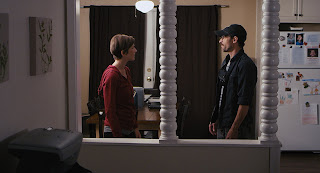Jay Dockendorf: Director of 'Naz & Maalik'
 |
| Scene from 'Naz & Maalik' by Jay Dockendorf |
Despite Dockendorf being from Los Angeles and only having lived in the city since 2012, the film feels thoroughly genuine and authentic. It's about two young, black Muslims who fell in love with each other. Despite the Yale University graduate also not being black or Muslim, Dockendorf is still able to tap into some universality here.
Prior to 2011, the English major was an editor at the Yale Daily News with a Muslim, female student who was very devout. He befriended her and worked regularly with her. After 2012, when he eventually moved to New York, his roommate in Brooklyn ended up being a Muslim man who was a closeted homosexual. Dockendorf befriended him too. Their friendship and their conversations formed the basis or set the tone for what would become Naz & Maalik.
At 26 years-old, Dockendorf has a day job in education. He mainly tutors, prepping people for the SAT for example. Dockendorf says he loves education and research, studying and learning new things. As such, he enjoys writing about subjects and characters who are different if not the opposite of him. He's more of a journalist in that regard. He thinks in general there is too much of a tendency in his peer group of navel-gazing or writing about oneself.
Because he was so bowled over by his roommate's story, Dockendorf felt compelled to make his script about being gay while in the Islamic faith. Having befriended several Muslim people, he felt comfortable writing this screenplay about them. After the film was complete, he screened it for those Muslim friends and they gave him positive feedback.
Dockendorf's former roommate is now a professor in the American northwest and has not seen the film yet. After some calculus about the likelihood of someone being able to directly identify with the titular characters of Naz & Maalik, Dockendorf doubts he'll ever meet someone who will randomly tell him that they're a Naz or a Maalik, and that he also told their stories.
If nothing else, it makes this directorial debut highly unique. Conversely, it makes his film very niche, but the first time filmmaker seemingly would not have it any other way. The review for my blog will give you an idea of how unique it is in terms of its characters and story. Other films have a similar structure and form, but in all honesty, there is nothing like this movie currently in the world.
And it comes from a young man who didn't think he'd be a director at first. He didn't even take any film classes at Yale. He studied music and even did some film scores in college, but in the summer following his sophomore year, he had an epiphany and decided to change course.
He remembers watching movies on the weekends with his babysitter. He was obsessed with The X-Files, a very cinematic TV series, as well as the films of those like Steven Spielberg. As he got older, he reveled in going to the theaters. He said he would see up to five movies a week. He's since slowed to one or two a week, but he says there's something "more arresting" with watching a film in a darkened theater on a large screen and surround sound.
He shot his film intending for it to be played on a big screen. Yet, Dockendorf used a digital camera, one that was adaptable and light enough for the cinematographer to carry on his shoulder for extended periods of time. It was necessary because the movie is constantly on its feet and constantly moving about Brooklyn.
One scene has the two titular characters selling perfume oils on the street. Dockendorf had his two actors interacting with non-actors, in many cases real people who just happened to be walking by this crowded area. The director says he likes crowds and shooting crowd scenes is something he liked to do more. He knew there could be chaos but that the chaos would make the movie stronger or more idiosyncratic. Not only did that require a fluid and light camera but also fluid actors, light on their feet as well, whether through improv or otherwise.
It's reminiscent of a scene in The Falls (2012) where director Jon Garcia had his two actors who were playing Mormon missionaries out on the street, not selling perfume oils, but trying to sell the ideas of the Church of Jesus Christ of Latter Day Saints. That movie also embraced real people who weren't actors naturally reacting to his stars. It really put the focus on the actors allowing them to shine. When it came to the scene of selling perfume oils, the same could be said for the actors starring in Naz & Maalik.
Shooting on the streets among crowds proved serendipitous for the production. However, shooting on the subway system proved a bit more difficult and not fun. It was thrilling, Dockendorf says, but not fun. One critical scene has the two protagonists reveal their feelings for one another on the subway. Next time, Dockendorf admits it might be best to rent the subway for a few hours because that critical scene, which only lasts a few seconds, took the production 17 hours to get. Aside from crew members lost by getting on or off at wrong places, the scene involved syncing two passing trains that they didn't control and it turned into a bit of a nightmare.
This article is being written in conjunction with the Frameline Film Festival. Naz & Maalik plays there on Friday, June 19 and Monday, June 22. Check the Frameline39 website for showtimes and tickets. For more information and future dates, go to http://www.nazandmaalik.com/ and follow https://twitter.com/naz_and_maalik.










Comments
Post a Comment